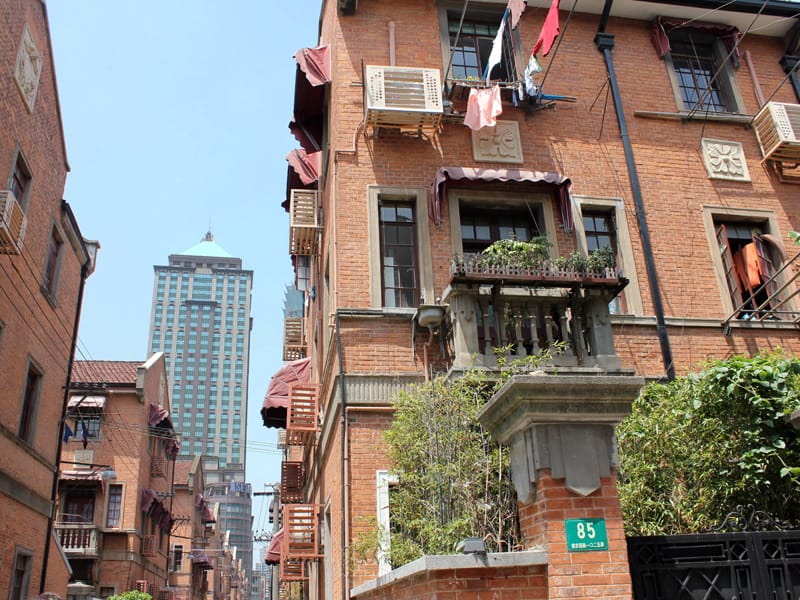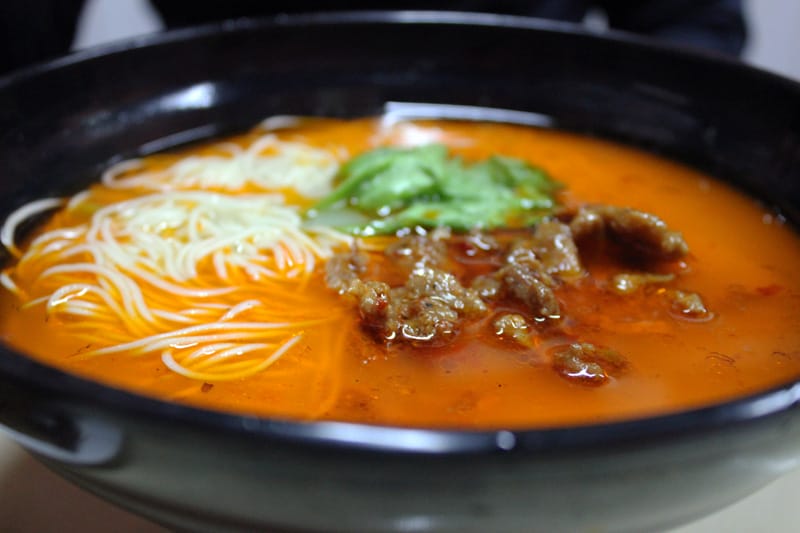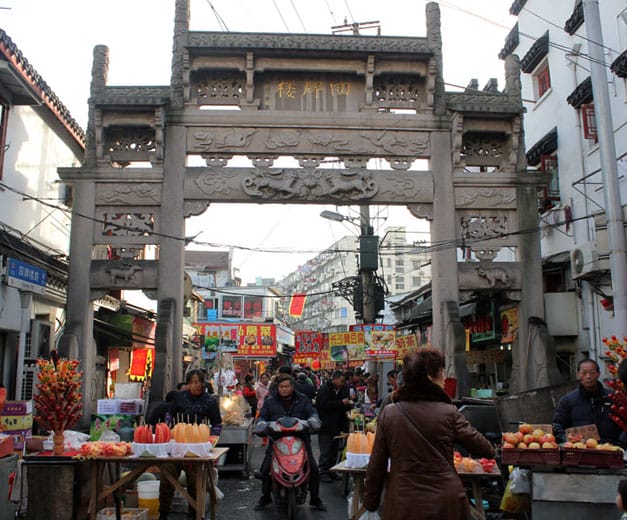Earlier in 2012, Jing’an Villas – a square, block-sized 1930s-era housing area in the heart of downtown Shanghai – survived an ironic plan that called for permanently relocating all of its 3,000-plus residents in order to better “preserve” the historic neighborhood. Luckily, the plan was shot down in a party committee meeting. For now, at least, Jing’an Villas remains the perfect setting for trying longtang cai, simple, home-style alleyway food that features local favorites. After all, food doesn’t get any more homemade than when it’s being cooked out the back door of someone’s living room.
Sandwiched among the skyscrapers in one of Shanghai’s most upscale office and shopping neighborhoods and easily accessible by subway, Jing’an Villas is comprised of 183 subdivided three-story units that were built in 1932. The architecture of the area was partly modeled on European-style row housing but also incorporated Chinese concepts of common space, resulting in a unique hybrid style of houses found only in Shanghai. This lilong, or neighborhood lane style, represented a new way of life for middle- and upper-income families; the dwellings usually featured indoor plumbing, an inner courtyard, a sitting  room and an indoor cooking area in a quiet, secure neighborhood. It is thought that at the height of the lilong era, Shanghai had more than 9,000 such housing complexes.
room and an indoor cooking area in a quiet, secure neighborhood. It is thought that at the height of the lilong era, Shanghai had more than 9,000 such housing complexes.
As housing shortages in Shanghai became more acute around WWII, landlords shifted to renting out individual rooms, and communities became increasingly dense. Today, the subdivided housing pattern continues, and many different units are available for rent, ranging from tiny 7 sqm rooms that go for about RMB 700 (about $112) a month to much larger units for RMB 9,000 (about $1,440) and more. Across the city, such neighborhoods are disappearing quickly. Thankfully, Jing’an Villas is safe for the time being and this thriving and evolving neighborhood continues to serve as a predominately residential area, with a few businesses and (mostly unlicensed) cafes and food stalls housed in the first-floor units.
For a bowl of midday noodles, visit stall #107 (Tel. +86 21 6215 4718, Hours: 7am-2pm), tucked away at the end of a quiet alley. Here, a small army of ayis, or “aunties,” serves up bowl after bowl of noodles to the lunchtime crowd. You’ll have to come early for their famous soup wontons; if you come at lunch, you’ll likely be offered a bowl of scallion oil noodles. Shanghai residents prefer their dishes on the sweet side, and these 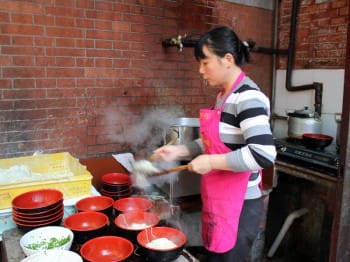 do not disappoint. Bowls of springy noodles flavored with a touch of Shanghai scallion oil broth lingering at the bottom of the bowl are a good start for a midday nosh. To make the meal a bit more filling, ask to have your noodles topped off with a stewed hard-boiled egg, a veggie “chicken” (素鸡, sùjī) fillet made from tofu, or a fried pork chop (猪排, zhūpái). The ayi gives your change with a smile and even a bit of English, a friendly reminder that you’re not really in a restaurant, but are more like an invited guest.
do not disappoint. Bowls of springy noodles flavored with a touch of Shanghai scallion oil broth lingering at the bottom of the bowl are a good start for a midday nosh. To make the meal a bit more filling, ask to have your noodles topped off with a stewed hard-boiled egg, a veggie “chicken” (素鸡, sùjī) fillet made from tofu, or a fried pork chop (猪排, zhūpái). The ayi gives your change with a smile and even a bit of English, a friendly reminder that you’re not really in a restaurant, but are more like an invited guest.
For a taste of the classics, check out stall #15 (No phone, Hours: Early morning to midafternoon) near the entrance at Nanjing Xi Lu. This is the place to go if you’ve just snacked your way around the lanes, cafes and small shops in the area but are hungry for something more substantial. There’s a catch here, something we’d never seen in Shanghai before: you’re going to have to write down your order yourself. Luckily, your friendly Shanghainese co-diners are more than likely to speak a little English and will help you slip your order to the one-woman-cooking-show out front. Like a pilot in a standing cockpit, this ayi has everything imaginable at ladle-distance. She’s fast, but if there’s a line, this may not be the best place for those who are in a hurry. The Shanghai classics – everything from pork wontons to fried rice, fried noodles and sliced stir-fried glutinous rice with greens (炒年糕, chǎo niángāo) – are on full display here. You may even get a crash course in writing by copying Chinese characters from the red display menu.
For the perfect cup of milk tea, stop by stall #128 (Tel. +86 21 6258 5031, Hours: 11am-7pm). Denny House (named after its owner, Denny Wong) is just a to-go window that opens out of a first-floor living room turned tea shop. It’s hard not to be charmed by the lack of a menu and the fact that you’ll be getting the same thing everyone else in line is having: Hong Kong-style milk tea. The house mix of tea leaves is brewed in the traditional manner but steeped for a longer than usual time in a large pot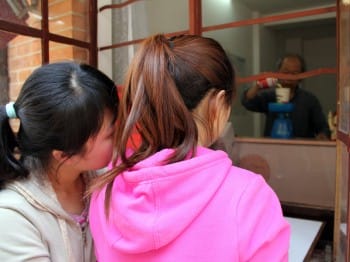 lined with a long cloth filter, which so resembles a lady’s undergarment that the beverage has been given the nickname “silk stockings milk tea” (絲襪奶茶, sīwà nǎichá). The sturdy cloth allows high-volume tea shops like Denny House to get a lot of mileage from a filter while also better handling the high temperature, longer steeping time and repeated use.
lined with a long cloth filter, which so resembles a lady’s undergarment that the beverage has been given the nickname “silk stockings milk tea” (絲襪奶茶, sīwà nǎichá). The sturdy cloth allows high-volume tea shops like Denny House to get a lot of mileage from a filter while also better handling the high temperature, longer steeping time and repeated use.
With a strong tea the need arises for a welcome balance of sweetness, which comes from a long pour of evaporated milk. Like just about everything else in Hong Kong, milk tea is a fusion of British and local traditions, and the result is a refreshingly smooth, rich cup of black tea to take you through the rest of the afternoon. Hong Kong-style milk tea is also the basis of the bubble tea craze that is spreading around the world. But you’ll need to add your own tapioca balls if you’re coming to Denny House – he’s not fussing with that.
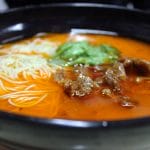 June 24, 2013 Ding Te Le
June 24, 2013 Ding Te Le
For a Chinese city as fast-paced and increasingly cosmopolitan as Shanghai, there are […] Posted in Shanghai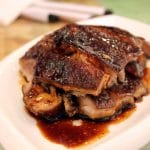 February 19, 2015 Guang Ming Cun
February 19, 2015 Guang Ming Cun
On one of Shanghai’s busiest shopping streets, amidst the glittering Tiffany & Co, […] Posted in Shanghai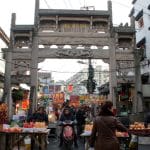 July 18, 2014 Fangbang Lu
July 18, 2014 Fangbang Lu
Editor's note: We're sorry to report that the vendors and restaurants at Sipalou Lu and […] Posted in Shanghai
Published on November 16, 2012
Related stories
June 24, 2013
ShanghaiFor a Chinese city as fast-paced and increasingly cosmopolitan as Shanghai, there are surprisingly few late-night dining options that don’t involve ordering from the roving, streetside pushcarts that hawk grilled skewers or fried rice and noodles. Unfortunately, these midnight vendors are not always where you want them to be when you need them most, after…
February 19, 2015
ShanghaiOn one of Shanghai’s busiest shopping streets, amidst the glittering Tiffany & Co, Piaget and Apple stores, Guang Ming Cun is housed in a nondescript four-story building. Glass displays in front offer a glimpse of the braised and dried meats for sale, and around the side you can peek in to watch flaky meat pastries…
July 18, 2014
ShanghaiEditor's note: We're sorry to report that the vendors and restaurants at Sipalou Lu and Fangbang Lu have suffered the same fate as those on Wujiang Lu and have been shut down. For street food, head to the area around Er Guang. In the lead-up to the 2010 World Expo, the government tore down one of…







































